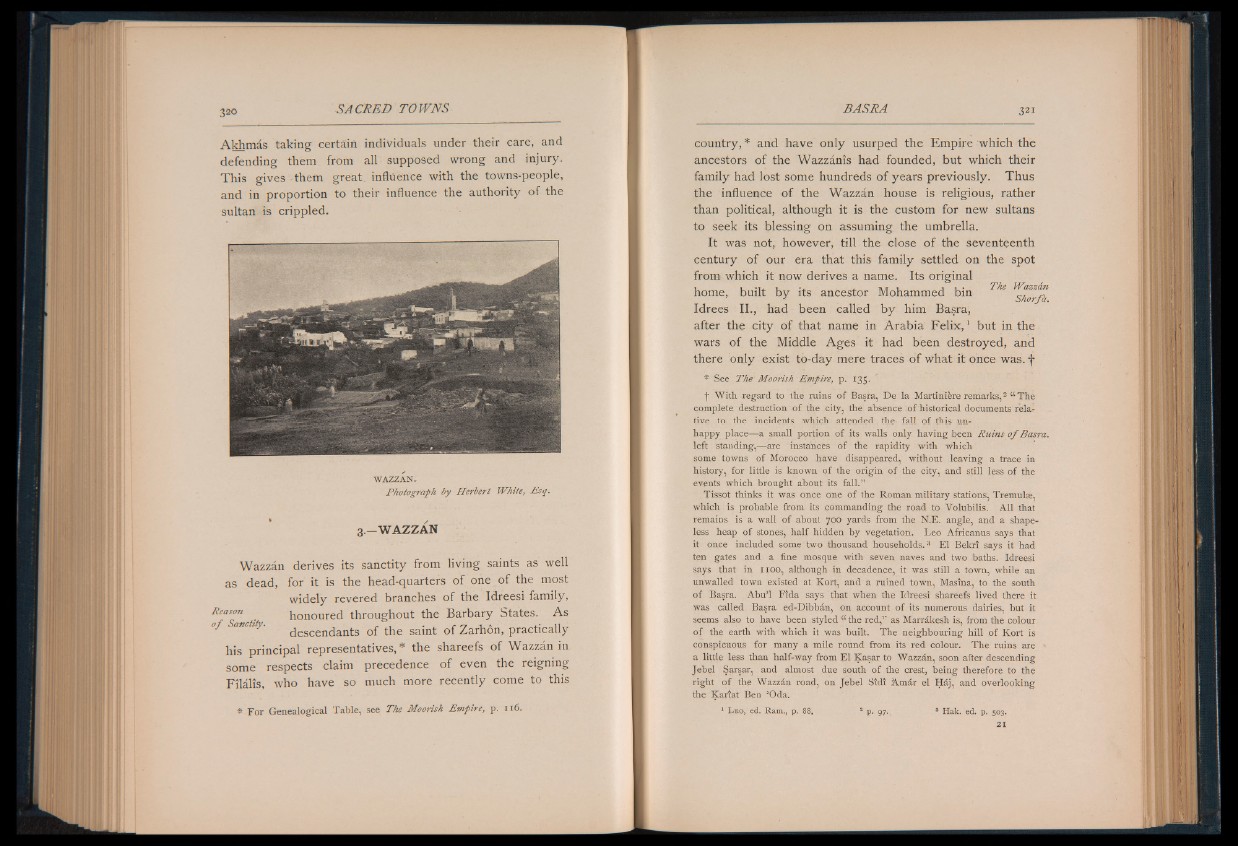
Akhmas taking certain individuals under their care, and
defending them from all supposed wrong and injury.
This gives them great influence with o 0 the towns-people,
and in proportion to their influence the authority of the
sultan is crippled.
WAZZAN.
Photograph by Herbert White, Esq.
3.—WAZZAN
Wazzan derives its sanctity from living saints as well
as dead, for it is the head-quarters of one of the most
widely revered branches of the Idreesi family,
Reason honoured throughout the Barbary States. As
descendants of the saint of Zarhon, practically
his principal representatives, * the shareefs of Wazzan in
some respects claim precedence of even the reigning
Filalis, who have so much more recently come to this
country, * and have only usurped the Empire which the
ancestors of the Wazzanis had founded, but which their
family had lost some hundreds of years previously. Thus
the influence of the Wazzan house is religious, rather
than political, although it is the custom for new sultans
to seek its blessing on assuming the umbrella.
It was not, however, till the close of the seventeenth
century of our era that this family settled on the spot
from which it now derives a name. Its original
home, built by its ancestor Mohammed bin Tfie J ^ Shorfa.
Idrees II., had been called by him Basra,
after the city of that name in Arabia F e lix ,1 but in the
wars of the Middle Ages it had been destroyed, and
there only exist to-day mere traces of what it once was. f
* See The Moorish Empire, p. 135.
f With regard to the ruins of Basra, De la Martiniere remarks,2 “ The
complete destruction of the city, the absence of historical documents relar
tive to. the incidents which attended . the fall of this unhappy
place— a small portion of its walls only having been Ruins o f Basra.
left standing,— are instances of the rapidity with which
some towns of Morocco have disappeared, without leaving a trace in
history, for little is known of the origin of the city, and still less of the
events which brought about its fall.”
Tissot thinks it was once one of the Roman military stations, Tremuls,
which is probable from its commanding the road to Volubilis. All that
remains is a wall of about 700 yards from the N.E. angle, and a shapeless
heap of stones, half hidden by vegetation. Leo Africanus says that
it once included some two thousand households.3 El Bekrl says it had
ten gates and a fine mosque with seven naves and two baths. Idreesi
says that in 1100, although in decadence, it was still a town, while an
unwalled town existed at Kort, and a ruined town, Masina, to the south
of Basra. Abu’l Fida says that when the Idreesi shareefs lived there it
was called Basra ed-Dibbdn, on account of its numerous dairies, but it
seems also to have been styled “ the red,” as Marrakesh is, from the colour
of the earth with which it was built. The neighbouring hill of Kort is
conspicuous for many a mile round from its red colour. The ruins are •
a little less than half-way from El Kasar to Wazzdn, soon after descending
Jebel Sarsar, and almost due south of the crest, being therefore to the
right of the Wazzan road, on Jebel Sldl Amdr el H£j, and overlooking
the Kartat Ben ‘Oda.
1 L eo, ed. Ram., p. 88. 2 p. 97. 3 Hak. ed. p. 503.
21